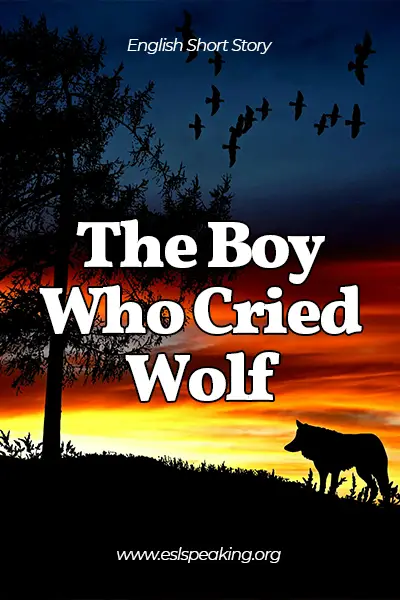If you are looking for a short English story that contains a great message, try reading “The Boy Who Cried Wolf.” We created three versions of the same stories to accommodate all reading levels. After reading the story, go over the list of vocabulary and reading comprehension questions to test if you properly understood the story. Reading and completing the comprehensive activity will help you improve your English reading skills.

The Boy Who Cried Wolf
If you know your English reading level, jump to the appropriate one. If not, start with the beginner level and see if you’d be able to challenge yourself to read the intermediate or advanced version of “The Boy Who Cried Wolf.”
Beginner
Once, in a small village, a boy named Sam watched over sheep. Sam thought it was funny to yell, “Wolf!” and trick the villagers. They ran to help, but there was no wolf.
Sam did it again, and the villagers were upset. Later, a real wolf came. When Sam called for help, the villagers didn’t believe him. The wolf hurt the sheep.
Sam learned to tell the truth. The story teaches us that being honest is important, so people trust us when we really need help.
Intermediate
Once upon a time in a little village, there was a boy named Sam who looked after the village’s sheep. One day, Sam thought it would be funny to trick the villagers. He climbed a hill and shouted, “Wolf! Wolf! A big, scary wolf is coming to get our sheep!” The villagers hurried to help, but there was no wolf. Sam laughed at the joke.
The next day, Sam did the same thing, shouting about a wolf that wasn’t there. The villagers were not happy, and they told Sam not to lie. A few days later, a real wolf came. This time, when Sam cried for help, the villagers didn’t believe him because of his earlier tricks. The wolf attacked the sheep, and some were lost.
Sam learned that telling the truth is important, and the villagers taught him that honesty is the best policy. The story of the boy who cried wolf helped everyone in the village understand the importance of being truthful and trustworthy.
Advanced
Once upon a time, in a small village, there lived a young boy named Sam. Sam was responsible for watching over the village’s flock of sheep. One day, feeling a bit mischievous, Sam thought it would be amusing to play a trick on the villagers.
He climbed to the top of a hill and shouted, “Wolf! Wolf! A big, scary wolf is coming to get our sheep!”
Hearing the boy’s cry, the villagers hurriedly grabbed their tools and ran to the hill to help. However, when they reached the top, they found no wolf. Sam couldn’t stop laughing at the villagers’ puzzled faces.
The next day, Sam decided to play the same prank again. Once more, he cried, “Wolf! Wolf! A fierce wolf is attacking our sheep!”
Concerned for their flock, the villagers rushed to the hill, only to discover Sam’s trick once again. This time, they were not amused, and they scolded Sam for his dishonesty.
A few days later, a real wolf appeared on the outskirts of the village. The frightened sheep bleated loudly, and Sam, genuinely scared this time, screamed, “Wolf! Wolf! A dangerous wolf is here!”
However, the villagers, remembering Sam’s previous false alarms, hesitated to believe him. They thought he was playing another trick and chose not to respond. Sadly, the wolf attacked the flock, and some sheep were lost.
Sam realized the consequences of his actions. The villagers, disappointed and saddened, explained the importance of honesty and trust. From that day forward, Sam learned that telling the truth was crucial, and he worked hard to regain the villagers’ trust. The fable of the boy who cried wolf taught everyone in the village the importance of being truthful, as credibility is earned through honest words and actions.
The Boy Who Cried Wolf: Moral of the Story
The moral of the story is that it’s important to tell the truth. If we don’t tell the truth, people might not believe us when we really need help. Being honest is the right thing to do.
Vocabulary
- trick: Deceive or outwit.
- villagers: People who live in a village (small town).
- attacked: Took aggressive action.
- honesty: The quality of telling the truth.
- fierce: intense; aggressive.
- credibility: The quality of being trusted and believed.

The Boy Who Cried Wolf: Reading Comprehension
Reading comprehension activities assess and ensure that the reader has understood the story. These questions test the basic understanding and thinking skills such as analysis and interpretation. If you are an English teacher, use these reading comprehension questions to evaluate your student’s ability to extract meaning, make connections, and apply the information they’ve acquired.
Comprehension Questions
- Why did Sam shout “Wolf! Wolf!” the first time?
- How did the villagers respond to Sam’s first and second cries for help?
- What happened when a real wolf came to the village?
- What did Sam learn from the villagers’ reaction to his pranks?
- What is the moral of the story?
Answers
- Sam shouted as a prank to trick the villagers and see their reaction.
- The villagers rushed to help when Sam shouted about the wolf, but they were disappointed when they found out it was a trick the second time.
- When a real wolf came, Sam shouted for help, but the villagers didn’t believe him because of his earlier false alarms. The wolf attacked the sheep.
- Sam learned that being honest is important because the villagers didn’t believe him when a real wolf came.
- The moral of the story is that it’s crucial to tell the truth because if we lie, people may not trust us when we really need help.
The Boy Who Cried Wolf: Join the Conversation
What are your thoughts on this famous short English tale? Do you agree with the moral of the story? Let us know in the comments. We’d love to hear from you.





Leave a Reply